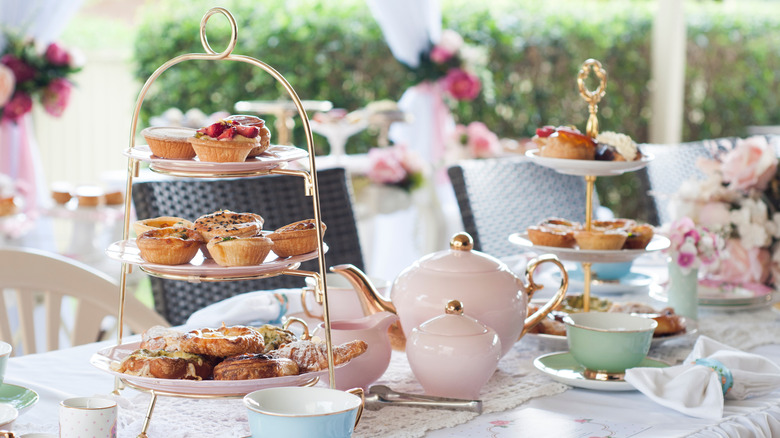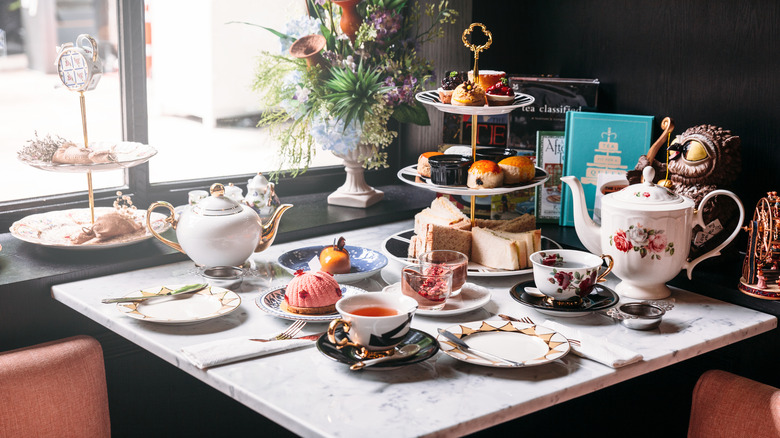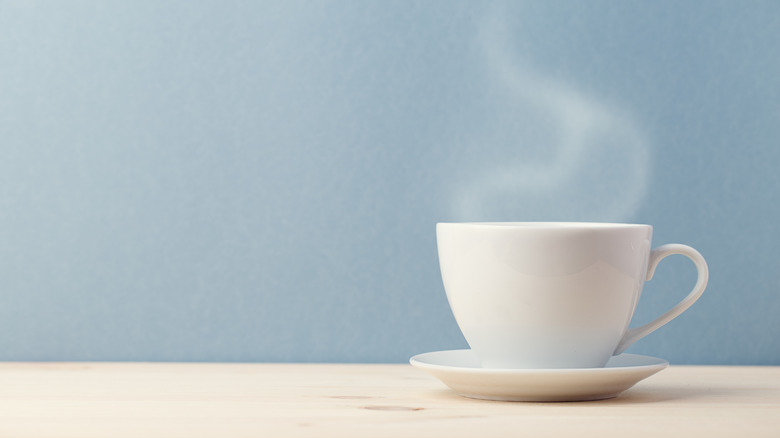A Classic 'High Tea' Isn't Actually As Fancy As You'd Think
Even though we declared our independence in 1776, Americans still love many British traditions. From The Beatles to cookbooks from "The Great British Bake Off," plenty of us are Anglophiles in the United States. And even though early Americans famously dumped a ton of tea into the Boston Harbor back in the day in protest of British rule, we still like to have tea time here as well.
In the U.S., we often picture "tea time" as one sort of all-encompassing event that's pretty formal. Our idea of tea has people decked out in tweed jackets, sweater sets, and fascinator hats, with white gloves and pinkies in the air. The Dowager Countess from Downton Abbey might be there, and there are piles of finger sandwiches and delicate cakes sitting next to carefully-steeped cups of Fortnum & Mason tea. Everyone is having a restrained — but delightful — time.
While there are certainly some similarities between the American understanding of British tea time to actual afternoon tea, there are also a lot of misconceptions. For starters, Brits drink tea all day and often into the night — up to 100 million cups every day, according to Reader's Digest. Ergo, although tea is a major part of British culture, it is not a special occasion beverage, so tea time across the pond isn't necessarily the fancy affair we picture it to be. In fact, there is more than one type of tea service, and "high tea" is not actually remotely fancy.
The types of tea times
A proper tea service with food (as opposed to just "a cuppa," which is a quick cup of tea) is typically either afternoon tea or high tea. They are similar in that there's obviously tea and food served; however, afternoon tea is more formal than high tea. What gets lost in translation in the States is where high tea gets its name.
Afternoon tea more closely resembles what most Americans think of as tea service, with three courses of food served with a pot of hot tea. "There's the savory course with tea sandwiches, the scones course served with clotted cream and jam, and, finally, the third course of sweet pastries," Chloe Hemery, head pastry chef at the Milestone Hotel & Residences in London said to Food & Wine. It's typically served around 3:00 to 4:00 p.m., and Hemery says this is because it's designed to tide people over between lunch and dinner. This service is also sometimes called "low tea" because it's served on a low table, like a coffee table.
High tea, as you might have guessed from the description of low tea, is typically served on a high table, like in the dining room. High tea is also traditionally served later in the day and has more substantial dishes.
What to eat at high and low tea
Now that you know that "high" and "low" refer simply to table height, the other most important difference between tea services is in what food is served and at what time. While afternoon tea is all about light bites, sweets, and leisurely midday snacking, true high tea is more of a working-class phenomenon. According to Brigit's Bakery, high tea is served when people are getting off of work around 5:00 p.m. and need something more satisfying to eat with their tea, like fish and meat dishes with more protein and substance. Dishes like beer-battered fish and chips or shepherd's pie would be perfect on a high tea table, for instance.
High tea is much more akin to a light dinner, only served with tea. In fact, Brigit's Bakery reports that lots of Brits simply call it "tea" and don't use the word "high." So, cultural tip: If you get home from work one evening and you're starving and start heavy snacking with a little salad and even a cookie, add a cup of Earl Grey and suddenly you're not snacking before dinner — you're observing a time-honored British tradition.


